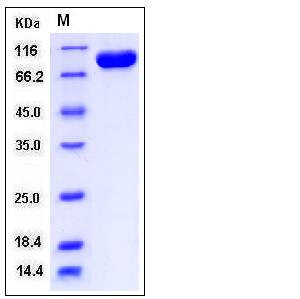Human Tie1 Protein (His Tag)
JTK14,TIE
- 100ug (NPP4311) Please inquiry
| Catalog Number | P10509-H08H |
|---|---|
| Organism Species | Human |
| Host | Human Cells |
| Synonyms | JTK14,TIE |
| Molecular Weight | The secreted recombinant human TIE1 comprises 750 amino acids with a predicted molecular mass of 81.4 kDa. The apparent molecular mass of rhTIE1 is approximately 80-90 kDa in SDS-PAGE under reducing conditions. |
| predicted N | Ala 22 |
| SDS-PAGE |  |
| Purity | > 97 % as determined by SDS-PAGE |
| Protein Construction | A DNA sequence encoding the extracellular domain of human TIE1 (NP_005415.1) (Met 1-Gln 760) was expressed, with a C-terminal polyhistidine tag. |
| Bio-activity | |
| Research Area | Signaling |Signal Transduction |Protein Phosphorylation |Tyrosine Kinase |Receptor Tyrosine Kinases |
| Formulation | Lyophilized from sterile PBS, pH 7.4 1. Normally 5 % - 8 % trehalose, mannitol and 0.01% Tween80 are added as protectants before lyophilization. Specific concentrations are included in the hardcopy of COA. |
| Background | Tyrosine kinase with immunoglobulin-like and EGF-like domains 1 also known as Tie1 is an angiopoietin receptor and is an orphan receptor tyrosine kinase that is expressed almost exclusively in endothelial cells and that is required for normal embryonic vascular development. The receptor tyrosine kinase Tie1 is expressed primarily in vascular endothelial cells. The receptor has also been detected in epithelial tumours in breast, thyroid and gastric cancers and in tumour cell lines where it appears as a 45 kDa truncated receptor fragment. Tie1 promotes endothelial cell survival, but other studies have suggested that the Tie1 kinase has little to no activity. Embryos deficient in Tie1 failed to establish structural integrity of vascular endothelial cells, resulting in oedema and subsequently localized haemorrhage. Tie1 is significantly higher in human aortic endothelial cells than in human umbilical vein endothelial cells. Additionally, attachment of cells of monocytic lineage to endothelial cells is also enhanced by Tie1 expression. Collectively Tie1 has a proinflammatory property and may play a role in the endothelial inflammatory diseases such as atherosclerosis. |
| Reference |
